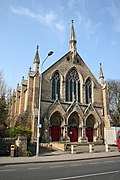History
William Botterill came to Hull in 1848 as clerk of works for the new Royal Station Hotel and set up an architectural practice in 1851. His son William Henry (1851–79) was also a partner in his practice. [2] John Bilson, [note 1] trained at the practice and became a partner in 1881. Botterill's son William Henry died early in 1879 and Bilson subsequently became the main partner in the practice, taking over the business when Botterill retired in 1899. [3]
The firm's commissions included chapels, houses, banks, offices, industrial buildings: commissions included the schools for the Hull School Board, with Botterill initially producing Gothic Revival designs, and later designs in the Queen Anne revival style by Bilson. Botterill designed the Newland Park Estate in Hull in 1877, though most of its houses were developed after his death. Oriel Chambers (now the home of the Wilberforce Institute for the study of Slavery and Emancipation [2] ) were built in 1879. [8] Bilson's work included the Jacobean style Hymers College (1893), the Boulevard Higher Grade School (1895), and classically styled buildings for the Hull Savings Bank built in the 1920s and after.
William Botterill, Botterill, Son & Billson, and Botterill & Billson works
Stepney railway station house, Hull. 1853
Centenary Methodist Chapel, Market Rasen. 1863
Methodist Chapel, Alford. 1864
Midland Bank, Hull. 1869–70
Tower Hill Methodist Church, Hessle. 1875-6
Oriel Chambers, Hull. 1879
Newington primary school, Hull. 1885
Hymers College, Hull. 1893
Boulevard Higher School, Hull. 1893
Hull Savings Bank (Derringham Bank branch), Hull. 1936
- Listed and other buildings, non-exhaustive list
William Botterill
- Stepney Station House, Hull (1853). [12]
- Centenary Methodist Chapel (1863). [13] [14]
- Methodist Chapel and Sunday School, Alford, Lincolnshire. (1864). [15]
- Exchange Buildings, Lowgate, Hull (1866). [16]
- 32, Silver Street, Hull (1869–70). [17]
- Offices. 2, Manor Street, Hull (1870). [18]
- Kings Market, South Church Side, Market Place, Hull (1875). [19]
- Oriel Chambers, Hull (1879). [8]
- Charterhouse School, Hull (1881). [20]
- Newington Primary School (1885) and adjoining nursery (1898), Hull. [21]
- Stepney Infants School, Hull (1886). [22]
This page is based on this
Wikipedia article Text is available under the
CC BY-SA 4.0 license; additional terms may apply.
Images, videos and audio are available under their respective licenses.









